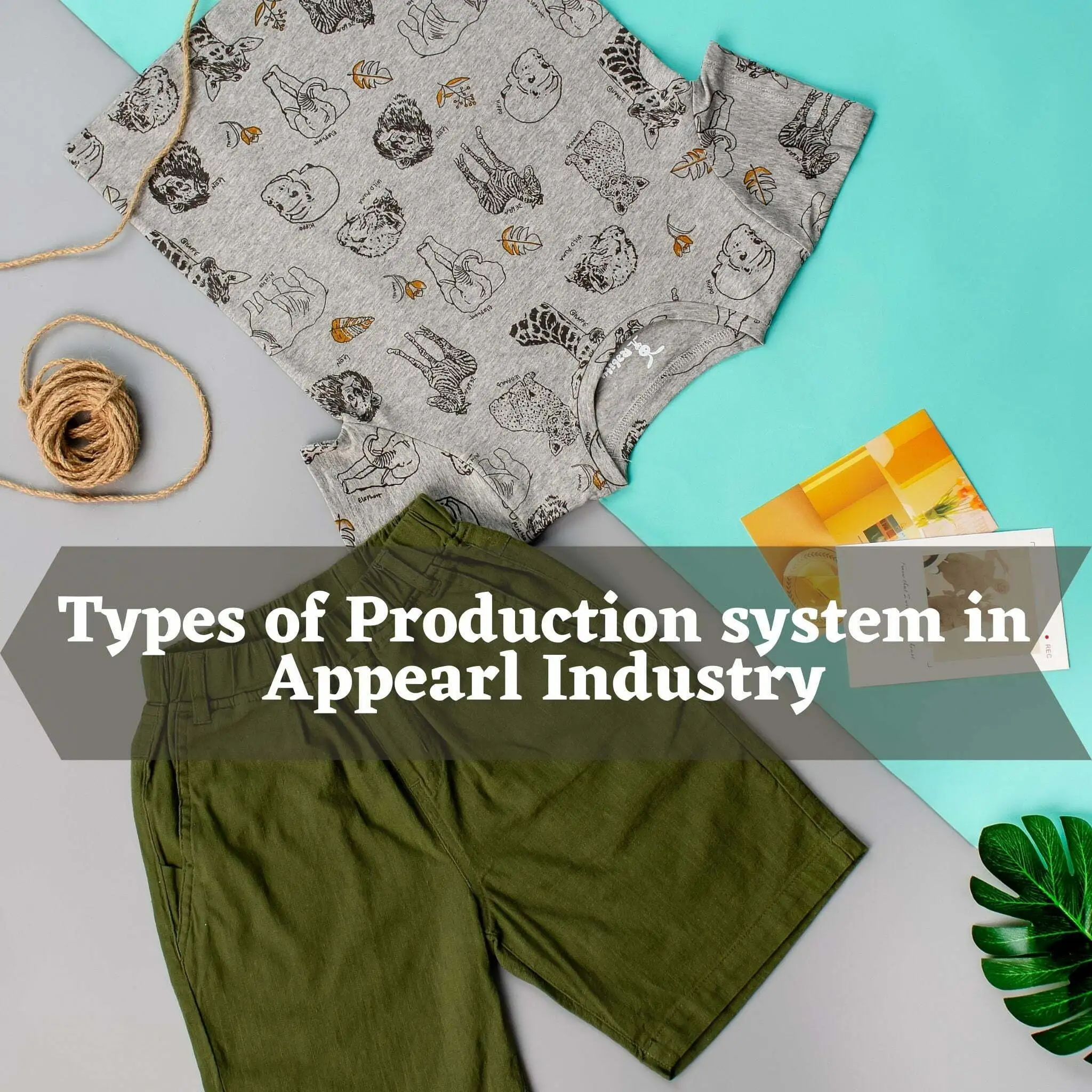The production system is the structure that allows production to occur. A production system includes attributes that are designed to convert inputs into desired or anticipated outputs. These attributes could be machine work, human labor or even tools. In the clothing industry production system, it is described by the term “an integration of material handling, production processes, personnel and equipment”.
Garment Production System:
Garment production systems are comprised of processes for production including materials handling, workers and equipment that manage the flow of work and create finished garments. It is a method that shows how the two-dimensional fabric can be transformed into a 3D garment within the manufacturing process. The names of production methods are derived from the various aspects like the use of many machines for assembling an item, the design of the machines, the total number of people involved in making an item and the number of pieces on a production line in the process of making the garment.
Every garment production system requires an appropriate management strategy as well as materials handling techniques as well as a layout of the plant to allow for the spread of garments and training for workers. The industry of garments can combine different production methods to meet their specific production requirements. This could mean using just one production method or a mixture of various methods for a particular style of garment. The design of a garment production system allows for the coordination of different production processes. There is no specific production method in the market that’s universally recognized but there are many different kinds of production methods used by various companies as described in the next section.
Production Systems Used in Apparel Industry:
The main goals of the system of production are
- Study the characteristics of various kinds of garment production systems.
- Comparing and contrasting the various production methods
- Analyze and critically evaluate the advantages and disadvantages of using various production methods in different situations
Types of Garment Production System:
The various types of production methods for garments have distinct requirements and different conditions to work. They must nevertheless fulfil two main requirements which are to conform to the specifications for the finished product as well as to be economical. The principal goal of any production process is to reduce the possible time of production. This will reduce inventory in-process and also its price. The sub-assembly method reduces the time for temporary storage to a minimum, by combining the temporary storage time and transportation time.
Every production system has four main elements which make up the entire system.
Processing time
The processing time represents the total working time for every operation involved in the production of an item.
Transportation time
Transportation time refers to the time needed to move completed or semi-finished clothes from one place to another or from one machine or operation to another.
Time for temporary storage
The time for temporary storage is the time when the bundle or garment is idle while waiting for the next processor to be completed particular components.
Inspection time
Inspection time is the time that is taken to inspect semi-finished garments for imperfections during the manufacturing process or for inspecting completed garments before packing.
In the industry of apparel, there are four kinds of manufacturing systems that are widely utilized: bundle system Progressive bundle system (PBS) Unit Production System (UPS) the modular systems. Bundle systems, as well as PBS, are classified into the mass production category, and Modular and UPS systems can be classified as flexible specialization.
Kanakadurga (1994) utilized five aspects of the production systems to categorize them in the clothing business into three types (i.e. the PBS, bundle system, or modular system). The five attributes included the workflow, the method for retrieving workstations the work-in-progress (WIP) inventory the number of tasks per worker, and the interaction between workers. The study revealed that a production system can distinguish itself from another due to these characteristics.
Make it through the System
It is the most common procedure of the production line, where an operator sews one piece of clothing at a time, performing all the sewing procedures required to put together an item. When the assembling process is completed for one piece of clothing, the worker will begin building the next piece and after that. In this type of system, the operator is given a set of pieces of work cut into pieces and then continue to assemble them according to their style of working. This kind of system works well when a large collection of clothes is required to be manufactured in a small amount.
The advantages of implementing the make-through process are
- Rapid throughput time
- Easy to monitor
The Weaknesses of the make-through technique are
- Low productivity
- The high cost of labor
- It requires a skilled operator to assemble it.
- This system is restricted to sample making and couture
Group System – Section or Process System:
This is an improvement of the original system with the exception that operators specialize in a specific component and stitch it from beginning to end. For instance, a person specializing in backs could sew the back, yoke, as well as label the back, attach it and label attaching, etc. And then, they perform every operation necessary to complete the component.
The sewing area would comprise many sections, each with skilled workers who can perform every operation required to make the specific piece of equipment.:
- Collar preparation
- Sleeve preparation
- Front preparation
- Back preparation
- Assembling the operations (closing the collars, setting collars and sleeves, etc.)
- Finalizing processes ( buttonholes blind-stitching, buttonholes, etc.)
Overall, this is an extremely efficient method to produce a range of styles at reasonable prices. Shows the typical design and workflow for this kind of system.
Benefits of the group system in the fashion industry:
- This system’s labor cost is less and the efficiency is better when compared to the make-through system because operators with different levels of expertise and machines are employed in this process.
- This technique is highly effective in creating a variety of styles in small quantities.
- Automatization and specialization can be achieved.
- Absenteeism and machine breakdown are not serious issues.
Group system disadvantages:
- The quality of the garments must be maintained at every level of workers taking part in the process.
- Highly skilled operators are needed for simple tasks in the department.
- The high cost of inventory is due to the high amount of work-in-process (WIP) which is required in this process because several people are working in every section.
- Because the cut pieces aren’t bundled in the situation of a bundling system there is the possibility of a lot of mixing up in terms of shade, size and colors.
Whole Garment Production System:
In the industry of apparel, the most basic production process is the complete garment system. It is a single operator who sews the pieces of fabric into the final garment. The majority of the time, this is done by traditional tailors and couture seamstresses. This method is labor-intensive as well as low in productivity and seldom found in modern production factories.
There are two sorts of manufacturing programs for complete clothes:
- Full complete garment
- Departmental complete garment.
In the whole-clothes system, one person is responsible for the whole garment, from cutting the cloth to sewing, pressing and embroidering the fabric. This garment will be ready to be shipped after the worker has completed the final step. This kind of system is employed in a few locations, that offer custom-whole sales They are usually costly and are made only for a specific customer. They are limited in quantity and distribution. Usually, around 10-20 pieces are made.
This departmental system of whole clothing is utilized by custom wholesale companies as well as high-end or higher-end dressmakers. In the departmental total garment system, one person performs everything using equipment assigned to a department. For instance, one person is responsible for all cutting work in the cutting department, another handles all sewing tasks in the sewing department The third is responsible for packing and pressing work. The employees who work in this system could utilize more than one piece of equipment to accomplish their job.
The advantages of the whole manufacturing system for garments:
- This technique is much more efficient in situations where a huge variety of clothes must be manufactured in small amounts.
- In the individual piece-rate system, the operator will be involved with complete involvement. To complete more pieces, to make more money.
- The Operator will be skilled in his specific area of work.
- Since the amount of money earned is contingent upon the difficulty of the procedure The operator attempts to finish the difficult task without difficulty.
- It is a case of the work-in-progress (WIP) is cut down, at any time, one cut garment is cut to one operator and thus the inventory quantity is reduced.
Advantages of the whole manufacturing of clothing:
- The cost of labour is greater because of the use of highly skilled workers for a specific task.
- The worker is more focused on the amount of work completed, rather than the caliber of the work.
- The lower productivity is because of a lack of expertise.
- In the long run, bulk quantities of similar designs are not efficient in this model.
Assembly Line System for Apparel Production:
In this type of garment production system, every worker is assigned one task or operation repeatedly. Certain features of this method are
- The cut pieces of clothing are transported from one work area to the next job.
- A bundle contains all the needed cut pieces for the final garment.
- Bundle tickets include a master list of tasks that match the specific style of clothing as well as coupons for each position.
- A ticket number is assigned to each bundle, which indicates the dimension, style and colour of the clothing.
The two major kinds of assembly-line production systems that are used in industry are
- Progressive bundle systems (PBS)
- Unit production system
Bundle system, as well as PBS to support the production of garments:
Many apparel Industry manufacturers think that the best method to achieve efficiency and economies of scale is through mass production. The bundle system allows manufacturers to benefit from the economics of scale. This bundle method, sometimes known as the traditional production method for garments is widely utilized by manufacturers of clothing for years. This is a distinct system that consists of cut pieces put into bundles to create some or all of an apparel Industry item.
The bundle system used in garment production is comprised of parts required for completing an operation or component. The bundles of clothing are made in the cutting room, where cut parts are matched with the appropriate parts and bundle tickets. The bundles are then moved to the sewing area and then handed over to the operator of the garment who is scheduled to finish the process.
PBS is a variant of the system of bundles. The principal characteristics of these PBS are that one person can perform only one skill at one time, there is no interactivity between the operations, compensation for piece rate and maximization of the productivity of the individual operator, requirement to have additional space for storage of materials and straight-lined equipment layout and manual movement of material in large quantities.
The system assists operators to make more units of clothing in a shorter time, and while causing greater quality issues. To help stabilize the workflow high levels of WIP can increase the production cost, not add quality, and result in longer time-to-market. In these types of systems, the difference between the actual run time and the total manufacturing throughput is substantial. The effectiveness of PBS is dependent on how it is set up and implemented in a facility.
Benefits of the PBS used in the garment industry:
- This production method could permit greater utilization of specially designed garment production equipment since the output of one specific automated garment machine could be able to supply multiple operators of the garment machine to run the next process.
- Small garment bundles enable faster throughput unless there is a bottleneck or lead times that are long within the operations.
Advantages of PBS in the production of clothes:
- The PBS is cost-effective for single garment operations. Since the workers who operate the garments operate every day, it allows them to improve the speed and efficiency of their operations which means that they’re less likely to learn a new procedure because it decreases the efficiency of their business and profits.
- The workers employed in PBS of garment production are independent. PBS manufacturing processes are not dependent on the other operators and the product.
- Absenteeism and machine malfunctions as well as slow processes are some of the biggest problems in this system.
- WIP is observed in large quantities in this system of production Which leads to a longer time to market.
- The poor quality of clothing is found in bundles that were kept secret due to the huge inventories that were created during the production process.
- This causes more handling and difficulties in controlling stock in the garment industry.
- Line balancing can be challenging most often.
- A proper plan is required for each batch and every style, which can take much time.
- Incorrect planning can lead to low productivity, low turnover of workers and lower production.
- The variety of styles and styles that are of smaller quantities aren’t effective in this type of system.



